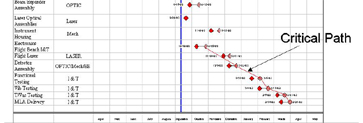
What was the most difficult thing for you about reforming the AMRAAM program?
Drawing down the work force. I’ve always done everything that the Air Force has asked me to do, and if they asked me to do a massive downsizing again, I know I would have to do it; but I pray to God, literally, they will find somebody else. I’ve done this once, and I don’t ever want to do it again. To stand in front of two hundred people and tell them that we are going to be down to less than a hundred in one fiscal year, that was really excruciating. A lot of them had been on the program for the full twenty years it was in existence. Many felt that their jobs were a reward for having made this program a success and thought they were going to stay there until they retired.
How much of a surprise to them was it when you told them this?
There was an Air Force mandate to draw down the work force — so everyone knew about it /– but they didn’t know what the plan was. The organization was about one year behind the mandated plan, for a lot of reasons. My predecessors had not embraced the drawdown and other parts of acquisition reform. So there was a perception going in that maybe the organization would be able to “escape” compliance with the drawdown directive and other aspects of acquisition reform, and that somehow it didn’t really apply to them.
Did that make it even harder to stand up there in front of them and say what you had to do?
Oh yes. I was in this environment where, one, people were sitting there very nervous about their jobs and, two, they believed their work was special somehow and would be left alone, if only I would argue for them as well as my predecessors had. I feared that I would be remembered as the slasher. Ultimately, I believe this fear drove me to be a better leader, because I focused on nurturing the people and the business in the organization.
How did that feel to be seen as a ‘slasher’?
That was very strange, I have to tell you. For at least a year or two, I would see people whispering when I walked up, especially people on the base outside my immediate organization. It was the first time in my life that I experienced a feeling of being disliked and gossiped about. But then slowly people got over it, once we got through that first phase, and in fact when the program became recognized as quite a success and won major awards and was featured in the newspaper, then a lot of the base and the community started joining in our joy, taking credit for it.
One year seems like a drastic amount of time to draw down your workforce by more than half. What made you decide to do it so quickly?
I thought about this a lot and I felt that if you are going to draw down the work force, you ought to decide how much you’re going to draw it down and you ought to do it as quickly as possible. You can do it slowly, but that seems to me like leaving yourself in a state of constant bleeding. My view was to do the amputation and let’s get well. Plus, I did not intend to just ‘pink slip’ people and say goodbye, good luck, and get out of here. We were going to be systematic about finding them work, both the civil servants and the support contractors.
Did telling them this make a difference?
That was not something they took to heart right away. Until you see it happening around you it is hard to fathom.
What were their reactions when you announced the drawn down plan?
It was very shocking. The room went silent. I invited them to ask questions, and there weren’t any. I had a friend who was in the program office at the time and I felt that she would be candid with me, so afterwards I asked her, “How do you think it went over and what was the gossip afterwards?” She said — and I knew for her to phrase it like this that it must have been really bad — “Well Judy, everybody knows you did the best you could, and at least you were honest with us.”
As the year went by, while the draw down was taking place, did you have any strategy for letting people communicate their concerns?
We had a team meeting every month, and we discussed where we were in the process. At every meeting, beginning with the first one where I announced the plan, people got a note card and could write anything they wanted. They could vent, they could give us recommendations — whatever. We took every recommendation that was printable, and at each team meeting we would get up and tell people what we had done. That allowed people to feel like they could really scream at us if they wanted.
What kind of things did people write?
Some people wrote down things like, “I feel very betrayed.” “Please don’t leave me without an job, I am the only one earning to support my family.” Other people wrote down things that were real petty like, “I’ve asked for the Xerox machine on our floor to be fixed over and over and it never works reliably.” And then other people would write really good recommendations. We implemented every recommendation, including getting the damn Xerox machine fixed.
What happened to the 100-plus people whose positions were eliminated?
This is something I’m very proud of. Almost all of the people who left the AMRAAM program, I would say 95%, got jobs in other programs. I had told them this at the first meeting, we were going to get them jobs, nobody was abandoning them, but like I said, until you see it happening around you it is hard to fathom. For government employees, there was plenty of work on the base. We had a handful of civil servants and support contractors who never got happy, they didn’t want to go work in another program, but they were older people who eventually decided to retire.
What was the impact of the reforms on the rest of the base?
Huge. AMRAAM was the largest program on the base, so the changes were going to be enormous. The program had grown up in an environment where many parts of the base received lots of money every year, like in the test wing, and they saw that as their right to the money.
How did you explain this to these stakeholders?
There were compelling reasons why we needed to reform. Basically, 50% of the unit cost of AMRAAM wasn’t going into the missile.
Where was all the money going?
There was a huge amount of redundancy and waste. For example, we had five different simulations checking the performance of the missile. All five were duplicating each other. At Eglin we had two, neither of which I could see the point of carrying. One was with the program from the beginning. The second was this brand new facility that was supposed to be the best in the world and all that. AMRAAM was the primary contributor. We pumped more money into that facility than I could believe. I didn’t see why we needed so many simulations. The contractor of course had to have his; he had to have some way of verifying his performance; but these others were just wasting a lot of money to duplicate data.
How did people who were involved in the areas react to you?
Well, many people were angry with me. There were mean e-mails that were forwarded to me, and some officials complained to my bosses in Washington. I had the support of my bosses in Washington, who told them point blank, “I pay my program directors to execute efficient and effective programs. I do not pay them to shore up work forces or facilities at the product centers.”
Still, it must have been difficult dealing with hostilities like that.
Whenever you are doing something really different, really innovative and creative, and you are out there trying to create something more powerful than your predecessors, you are going to have attackers. There are going to be people who don’t agree with you. People will feel threatened by you. If they fundamentally don’t believe in changing the way they do things, you can’t convince them to like changing. You can only hope they will leave you alone until they can see that the change is working.
I imagine you had to brief the Base Commander often on what you were doing. How did that go?
One thing I learned about myself is that I am not a quitter. I briefed him once and the tension in the room was thick enough to slice with a dull knife. He was quite aggressive in his criticisms. I was courteous and replied over and over, “Noted sir, next chart.” At the end, I said, “Thank you very much for your attention today and all the time you have given me. I am the Program Director and I will proceed as planned with this program. Thank you very much.” Through all of this I was just extremely courteous. I always tell people that these are very powerful things to say, “Thank you very much, I have noted all of your concerns. This is the way I am dealing with them, this is the way we’re going.” You can beat down a whole lot of bureaucracy by doing that.
Did that come naturally, or did you have to swallow hard to say those things?
It is never easy to sit calmly and not become argumentative when you are being attacked. I practiced a lot in front of a mirror. But seriously, it is a difficult thing to do for most of us, but if you can’t do it you will sooner or later become stunted as a leader.
I know you are often invited to speak about leadership. What do you regard as the key ingredients of a leader?
It seems to me that people are leaders when they have a compelling vision that is really part of their heart and soul. They really believe it. And it comes out of them kind of like poems come from the great poets. It’s part of their soul, and it’s part of how they think about the world. When that vision comes forward, they haven’t had a committee get together and write them a vision statement on a plastic card — it is part of their core being, and you can just tell. And when you work for someone like that, you know her vision is who she is. Every now and then in our lives, we have gotten to work with someone like that. And we say, “Oh my God, this time will not come again,” because we know where we a re headed and we know what the vision is, and we know it’s got to be a good vision or else this person would not believe in it and love it the way she does. So that is what I think leadership starts with: a person who has a vision that is the core of her soul and beliefs.
Read another article on workforce reduction:
Thank You, Judy
Search by lesson to find more on:
- Budgets









